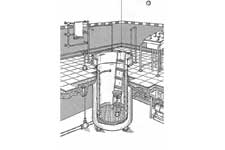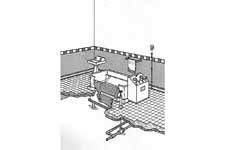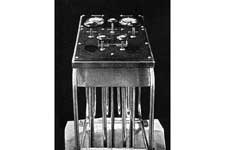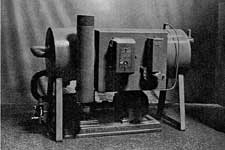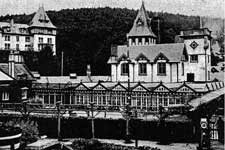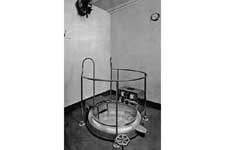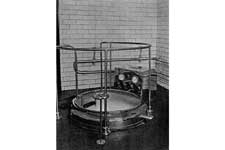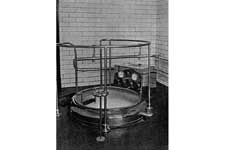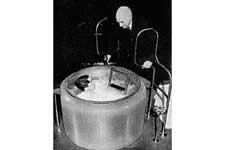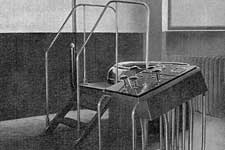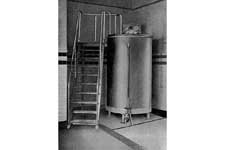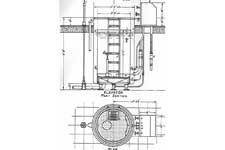Turbulayr Products Ltd
Text of booklet
THE ‘AERATONE’ THERAPEUTIC BATH (OLIVER PATENT)
British Patent No. 498,156 Canadian Patent No. 388,717 United States of America No. 2,174,445 French Patent No. 841,945 Italian Patent No. 365,440 Patents pending in Germany and Scandinavia
For
THE TREATMENT OF CIRCULATORY AND RHEUMATIC DISEASES
A powerful hydraulic machine for applying a controlled vibrating massage to all parts of the immersed body simultaneously at a comfortable temperature, under conditions of complete relaxation and at one operation
Manufacturers and Sale licensees of the ‘Aeratone’ Bath
TURBULAYR PRODUCTS LIMITED
STAINLESS STEEL SPECIALISTS
WEST HARBOUR ROAD, EDINBURGH, 5
TELEPHONE: 84392 TELEGRAMS: ‘TURBULAYR, EDINBURGH’
Booklet 114
THE ‘AERATONE’ BATH
PARTIAL SECTION IN PERSPECTIVE OF SUNK VERTICAL TYPE BATH WITH SEPARATE CONTROL PANEL
THE ‘AERATONE’ THERAPEUTIC BATH (OLIVER PATENT)
INTRODUCTION
The ‘Aeratone’ Therapeutic Bath represents the latest introduction in the field of Hydro-Therapy, and is a powerful aid in the treatment of Circulatory and Rheumatic Diseases.
Although this equipment is termed a Bath, it is at the same time a very powerful machine which combines Air, Massage, Warmth and Water and provides for the application of a vibrating hydraulic massage, variable in strength at will, to all parts of the immersed human body simultaneously at a comfortable temperature and under conditions of complete relaxation and comfort for the bather.
The ‘Aeratone’ Bath is essentially safe in use, since the conditions of strength of massage and temperature are under complete control throughout the treatment, and can be varied over a wide range to suit the very delicate patient on the one hand and the physically strong patient on the other. The patient is not hit or beaten by the action of the air and water, so that there can be no injury, while the Bath has a stimulating effect on the heart.
Many thousand treatments have been given in the ‘Aeratone’ Bath installations throughout Britain, and much valuable data has been accumulated which shows conclusively that this new Bath places at the disposal of the medical profession a powerful piece of apparatus for the treatment of such stubborn complaints as muscular rheumatism, fibrositis, arthritis, sciatica, lumbago, muscular strains and varicose vein ulcers, while mental depression, lethargy, high blood-pressure and run-down conditions respond satisfactorily to the ‘Aeratone’ treatment. In fact, any troubles for which it is customary to prescribe massage will be found in general to respond to the ‘Aeratone’ treatment.
The persistent, untiring application of the vibrating hydraulic massage throughout the treatment under relaxed conditions and can be provided with a slung chair so that the patient can be lowered into the treatment chamber in comfort. (This arrangement is shown on Fig. No.2.)
Two pages are missing from the original at this point
FIG. No, 2. ‘Aeratone’ Bath Installation showing also Overhead Runway and Lifting Chair for helpless Patients, now installed in the Works Treatment Centre at the Works of Messrs Newton Chambers Ltd., Thorncliffe, near Sheffield.
The treatment chamber is provided with a perforated floor-plate carrying a perforated adjustable stool upon which the patient sits at ease with the shoulders level with the top edge of this chamber. The central air-diffuser, in the form of an inverted cone, is mounted below the perforated floor-plate, and provides the upward flow of air bubbles in the treatment chamber. The surround air-diffuser, in the form of a perforated circular pipe, is disposed round the bottom of the annular space between the wall of the treatment chamber and the outer bath cylinder. This air-diffuser provides for the upward flow of water in the annulus, and causes the water in the annulus to rise and cascade over the top edge of the treatment chamber, where it forms a downward flow of water meeting the rising current of bubbles from the central air-diffuser, thus giving rise to the vibrating hydraulic massage, one of the outstanding features of the ‘Aeratone’ Bath. A substantial emptying valve is provided for rapidly emptying the bath, while an overflow orifice is also provided. The necessary connections are provided for the compressed air supplies to the air-diffusers and for the hot and cold water supplies. The bath cylinder, inner cylinder, floor plate and airdiffusers are of welded and polished stainless steel construction throughout, presenting a smooth and eaSily cleaned surface with no corners and in line with modern hygienic ideas. If, therefore, any chemical additions to the water, solid, liquid or gaseous, are prescribed for particular treatments, these can be made without any danger of injury to the bath or its fittings. The main bath vessel is mounted on adjustable supports which allow of easy erection and levelling, and is provided with a surround pipe on its top edge which forms a wash-down spray or cold spray if desired.
There are three different arrangements for the erection of the Vertical Bath, depending on the site conditions :
(a) If a basement is available below the bathroom floor, the Bath vessel may be entirely lowered through the hole in the floor, leaving only a small portion of the Bath projecting through the bathroom floor as shown on Fig. No.5 and Frontispiece.
(b) The Bath may be partially lowered through a hole in the bathroom floor, but leaving about 2 ft. 6 in. of the Bath vessel projecting into the bathroom, entrance into the Bath being effected by means of a short stair with hand rails. This arrangement is shown on Fig. No.2.
(c) If no basement is available below the bathroom floor, the Bath is erected at its full height on the bathroom floor, entrance being gained by a full stairway with hand rails as shown on Fig. No.7.
(A) (2). The Horizontal Bath, developed for those who prefer to undergo treatment in a horizontal position, operates under exactly the same principles as those governing the operation of the Vertical ‘Aeratone’ Bath, and is just as effective. This type of Bath consists of an outer rectangular polished stainless steel water-tight vessel open at the top and provided with two weir plates of the same material and finish which form the sides of the treatment chamber and take the place of the circular treatment chamber of the Vertical Bath. The bottom of the treatment chamber is formed by a perforated polished stainless steel plate on which the patient reclines, an adjustable canvas strap suspended from the top edges of the weir plates being provided to support the patient's head. The Bath vessel is sunk into the bathroom floor, leaving about 2 ft. projecting into the bathroom, access to the treatment chamber being gained by stepping over the end of the Bath, while an overhead runway and sling can be provided for handling helpless patients into the treatment chamber. The central air-diffuser, modified in shape to suit the rectangular form of Bath, is mounted on the bottom of the main Bath vessel directly below the perforated floor-plate of the treatment chamber, and provides the upward flow of air bubbles in this chamber. The side air-diffusers, comprising perforated stainless steel pipes disposed between the weir plates and the sides of the main Bath vessel, provide the upward flow of water behind the weir plates over which the water cascades into the treatment chamber where it forms a downward flow of water meeting the rising current of air bubbles from the central air-diffuser, thus giving rise to the vibrating hydraulic massage on the reclining patient's body. The control gear and general construction follow the same lines as the Vertical ‘Aeratone’ Bath described under (A) (I), see page 5. The Control Panel, in polished stainless steel, is placed at the end of the Bath remote from the patient's head, so that the operator has the patient in full view while adjusting conditions in the Bath. The general arrangement of the Horizontal ‘Aeratone’ Bath is shown in Fig. No.3.
FIG. No. 3. Partial Section of ‘Aeratone’ Horizontal Semi-Sunk Type Bath with Control Panel attached.
(B). The Control Desk of polished finish , as shown on Fig. No. 4, carries on its upper surface bakelite , panels on which are mounted the following gauges and valves with which to control the conditions in the Bath :
- 1. A Dial Thermometer with connecting capillary tube and Thermometer Pocket.
- 2. An Air Pressure Gauge.
- 3. A Hot Water Valve.
- 4. A Cold Water Valve.
- 5. A Wash-down or Cold Spray Valve.
- 6. A Valve controlling the Central Air-diffuser.
- 7. A Valve controlling the Surround Air-diffuser.
An alternative form of control panel is provided where it is desired that the bather should be able to control the conditions in the Bath. This control panel takes the form of a polished stainless steel box carrying the same equipment as described above, and is placed adjacent to the Bath so that the controls are within easy reach of the bather undergoing treatment. This type of control panel has been widely adopted for Colliery Pithead ‘Aeratone’ Bath installations, and dispenses with the services of a bath attendant. (This arrangement is illustrated on Fig. No.5.)
The Control Panel for the Horizontal Type Bath is on similar lines to the Colliery Type described above, but is reversed so that the Gauges and Control Handles face the attendant as illustrated on Fig. No. 3.
(C). The Air Compressor is of the sliding vane blower type driven by an electric motor. The compressed air passes through a non-return valve into a small balancing air receiver and thence to the Bath. The equipment includes an air inlet silencer, an air outlet silencer, a safety valve and an air filter. The electric motor is started and stopped by means of an automatic self-acting starter actuated by a pressure regulator connected to the air receiver. After the main supply switch to the motor is closed, complete control of the motor is obtained by the operation of the air valves at the control desk. There are therefore no electrical connections near the Bath, with the consequent entire absence of danger from electric shock either to the patient or the attendant. (See Fig. No.6.)
NOTE:- It should be emphasised that there are no mechanical moving parts in the Bath-only air and water-and every care has been taken to provide a smooth, rounded design throughout so that bathers can be encouraged to move about freely in the treatment chamber without danger to themselves, thus exercising stiff joints, limbs and muscles with small expenditure of energy. The construction of the Vertical Type Bath is clearly shown on Fig. No. 19, where the various parts are lettered and a key to the letters is provided on page 30. The leading dimensions of the Bath are shown on the drawing.
FIG. No. 4. Standard ‘Aeratone’ Bath Control Desk.
FIG. No. 5. Manvers Main Collieries Pithead Bath ‘Aeratone’ Bath Installation. Wath-on-Dearne. near Rotherham. Sunk type of Bath with self-contained Control Panel operated by bather.
FIG. No. 6. Standard Air Compressor Equipment for ‘Aeratone’ Bath Installations.
FIG. No.7. Strathpeffer Spa, Scotland, ‘Aeratone’ Bath Installation, showing ‘Aeratone’ Bath standing full height on bathroom floor with entrance stair.
FIG. No.8. Strathpeffer Spa Buildings, Scotland. One ‘ Aeratone’ Bath installed, see Fig. No.7.
OPERATION
The bath being simple to operate, requires no special technical knowledge or skill, and the bath attendant soon acquires the experience necessary to apply the prescribed form of treatment for the different types of patient. Complete control of the conditions in the bath is effected from the control desk, and the temperature and the weight of vibrating hydraulic massage can be varied to suit the .patient.
The sequence of operations is then as follows :
I. Close the main switch controlling the electric motor. The motor will immediately start up and the air pressure will rise in the air receiver until it reaches about 6 to 7 lbs. per sq. in., at which point the motor will automatically stop. The lubricating points on the motor and compressor should be looked over occasionally, but, other than this, little supervision is necessary.
2. The bath is now filled with water at the desired temperature, probably between 92° F. and 98° F., to a level of about five inches below the top edge of the treatment chamber. The air valves may then be opened for a few moments to ensure that the mixture of hot and cold water is uniform in temperature. Bath water temperature being a matter of personal habit, it is desirable to ascertain what temperature the patient is accustomed to. As, however, the patient is sitting or lying in hot water up to the neck level, the water will generally feel somewhat warmer than water at a corresponding temperature in the ordinary plunge bath, and allowance should be made for this fact. Water temperature is not in general an inherent feature of the ‘Aeratone’ treatment, and it is merely a matter of providing a comfortable medium in which the patient can sit or lie at ease through the period of immersion. It will be found that the water temperature will fall about 2° F. during a 20-minute immersion, and this slightly falling temperature characteristic is found to be rather beneficial than otherwise. Indeed, physically strong patients experience an invigorating effect if the water temperature is rapidly lowered at the end of the treatment period to say 80° F. or thereby for a few moments.
3. The patient is introduced and seated comfortably on the adjustable stool in the treatment chamber as shown on Fig. No. 18, page 29. The patients' shoulders should be about level with the top edge of the treatment chamber, and the water level will have risen about 3 inches, due to displacement by the patient's body, leaving the top edge of the treatment chamber about 2 inches above still water level.
4. The surround or side air valve is now gradually opened, and air bubbles enter the water contained in the annular space between the walls of the treatment chamber and the main bath vessel. The effect of this air is to reduce the density of the water in the annulus relative to the water in the treatment chamber, and as these two liquids are in direct contact under the bottom edge of the inner cylinder or weir plates, the heavier liquid in the treatment chamber presses down under the inner cylinder or weir plates, and pushes the lighter liquid in the annular space upwards until it pours ' over the top edge or sides of the treatment chamber in a cascade, forming a continuous downward flow in the treatment chamber during the whole period of treatment.
5. The central air valve is now gradually opened, and air bubbles enter the treatment chamber from the air-diffuser situated below the perforated floor plate. These bubbles form an ascending stream struggling vigorously upwards against the retarding downward flow of water entering the treatment chamber from the annulus or sides. This struggle causes the air bubbles to vibrate as they pass upwards, continually striking and rebounding from the surface of the patient's body. As each bubble comes in contact with the skin, a quantity of water is pushed away from the skin, and on the rebound the water rushes back to fill the space left by the rebounding bubble, causing a slight depression of the skin at the point of contact. When it is realised that each bubble, during its ascent through the treatment chamber, comes into contact with the patient's skin many times, and that there is a vast number of bubbles steadily ascending throughout the treatment, some idea is gained of the extent and character of the vibrating hydraulic massage being applied to all parts of the patient's body simultaneously under relatively constant temperature conditions. Since the patient is sitting upright in the Vertical Type Bath, the application of this massage is in general at right angles to the vertical axis of the body or to horizontal axis in the Horizontal Type Bath, and the patient is therefore exerting no fatiguing muscular reaction, but is, in effect, in a condition of complete and pleasant relaxation. The relaxed muscles, tissues and joints are in a condition to benefit to the maximum extent from the vibrating hydraulic massage. The upward flow of bubbles and the downward flow of water gives the patient a sense of lightness which encourages freedom of movement, a very valuable characteristic, especially in the treatment of arthritis. During the period of treatment the muscles of the body are in a state of gentle vibration while the blood circulation is stimulated to a high degree. At the termination of a treatment, which may last from 15 to 25 minutes, depending on t he patient, it will be found that the skin condition appears to be unchanged , and there is no redness similar to that resulting from immersion in a still hot bath at the same temperature. In fact, the patient comes out of the bath feeling stimulated and energised, while he experiences a pleasant internal glow which may persist for hours after the treatment. It should be understood that the weight of the massage is controlled by the central air valve, and that the more this air valve is opened, the heavier will be the massage and the lower will be the reading on the pressure gauge on the control desk.
6. Since the Bath is constructed of polished stainless steel, the surface will remain bright, clean and hygienic. It is, however, a wise precaution to fill up the bath every three or four days with water at about 150°-160° F., and after putting say 3 to 4 lbs of washing soda and about a quart of sodium hypochlorite in the bath, to turn on both air valves and allow the circulation to run for 30 minutes. This process will thoroughly cleanse every part of the Bath, and will supplement the usual wash-down after each patient. Some waters may cause a slight scale to form on the surface of the Bath vessel which resists the treatment suggested above. If so, use 2 pints of hydrochloric acid occasionally in the cleaning process, and this will generally be found effective in removing the scale.
TREATMENT
As a result of many hundred test immersions carried out on behalf of members of the medical profession, it has been proved that immersion in the ‘Aeratone’ Bath is advantageous in the treatment of the ailments indicated on the Schedule of Treatments, but this list by no means exhausts its possibilities. The Schedule of suggested treatments, although based on the treatment of specific cases, is given for the general gUidance of bath attendants, and it must be understood that considerable latitude is permissible owing to the wide variation of conditions experienced in practice. If a patient complains of fatigue in the Bath, attendants should not hesitate to cut short the period of immersion. It will generally be found that delicate patients can be worked up gradually to the normal immersion period after a few baths have been taken. In order to take full advantage of the stimulated blood flow arising from treatment in the Bath, patients should be encouraged to rest after treatment for 15 to 30 minutes. As with most other bodily activities, a gentle start is advisable, and the desire to get striking immediate results should be rigidly held in check. Patients should be warned that the first one or two treatments are in the nature of acclimatising treatments. The results begin to appear after the acclimatising process is completed. Similarly, patients may feel a little muscular stiffness after the first treatment. This arises from the fact that the patient's muscles have been given unaccustomed exercise. This stiffness rapidly wears off, and is not usually experienced after further treatments.
FIG. No.9. Michael Nairn & Co. Ltd., Nether Street, Kirkcaldy, Fifeshire. ‘Aeratone’ bath Installation, in Works Welfare Department, presented by Sir Michael Nairn, Bart.
FIG. No. 10. Wharncliffe Silkstone Colliery Pithead Bath ‘Aeratone’ Bath Installation, Tankersley, near Barnsley, Yorkshire. Sunk Type of Bath with self-contained Control Panel operated by bather.
FIG. No. 11. Wharncliffe Silkstone Colliery Pithead Bath ‘Aeratone’ Bath Rest Room, Tankersley, near Barnsley, Yorkshire. One ‘Aeratone’ Bath installed, see Fig. No.10.
FIG. No. 12. Cannop Colliery Pithead Bath ‘Aeratone’ Bath Installation, Coleford, Gloucester. Sunk type of Bath with self-contained Control Panel operated by bather and showing miner undergoing treatment.
FIG. No. 13. Carnegie Baths, Pilmuir Street, Dunfermline, Fifeshire, ‘Aeratone’ Bath Installation. Semi-sunk Type of Bath with short entrance stair and showing patient undergoing treatment. Two ‘Aeratone" Baths are installed.
‘AERANOL’
A preliminary supply of 10 lbs. (about 64 doses) of this fragrant pine-scented fluid is supplied with each Bath. This fluid is specially prepared to improve the air-holding properties of the water by a marked increase in the surface tension. The dose per bath should be about 2 to 3 fluid ounces, and it should be added to the bath water after the patient is seated in the treatment chamber and the air turned on. The use of ‘Aeranol’ also adds pleasure and comfort to the bath, but it is not an absolute necessity, since plain tap water provides all that is essential. At the same time, it should be noted that ‘Aeranol’s maintains in suspension a large quantity of minute air bubbles which contribute to a secondary stimulating massage on the surface of the skin.
THE ‘AERATONE’ THERAPEUTIC BATH
SCHEDULE OF SUGGESTED AVERAGE TREATMENTS
| AILMENT | No. of Baths per Course. | Duration of Bath in Minutes. | Frequency of Baths. | Water Temp. Deg. F. | Surround Air Valve Fully Open Centre Air Valve: |
||
|---|---|---|---|---|---|---|---|
| Beginning of Course. | Middle of Course. | End of Course. | |||||
| Arthritis | 12 | 15/20 | Every other day | 94/98 | ½ Open | ¾ Open | Full open. |
| Fibrositis | 12 | 20 | Every other day | 94/98 | ½ Open | ¾ Open | Full open. |
| High Blood Pressure | 6 | 15/20 | At two Day intervals | 94/98 | ¼ Open | ½ Open | ¾ Open. |
| Lumbago | 4/6 | 20/25 | Every day | 98/100 | ¾ Open | Full open. | Full open. |
| Mental Depression | 12 | 20 | Every other day | 94/98 | ½ Open | ¾ Open | Full open. |
| Poor Blood Circulation | 12 | 20/25 | Every day | 94/98 | ½ Open | ¾ Open | Full open. |
| Rheumatism | 12 | 20/25 | Every other day | 94/98 | ½ Open | ¾ Open | Full open. |
| ‘Run-down’ Conditions | 12 | 15/20 | At two day intervals | 94/98 | ½ Open | ¾ Open | Full open. |
| Sciatica | 6 | 15/20 | Every other day | 94/98 | ¼ Open | ½ Open | ¾ Open. |
| Strains and Sprains | 6 | 20/25 | Every day | 98/100 | ¾ Open | Full open | Full open. |
| Varicose Veins | 12 | 20/25 | Every other day | 94/98 | ½ Open | ¾ Open | Full open. |
NOTE.- After patients have completed their prescribed Course, they should be advised to undergo subsequent treatments at intervals of one or two weeks. In fact, they should be encouraged to acquire the ‘ Aeratone’ habit, the benefits of which will speak for themselves.
MEDICAL REPORTS AND OPINIONS
As already indicated, the field of application for this new Bath is very wide, and although a considerable amount of research work has been done, this research work has been confined mainly to rheumatism and allied complaints. There is every reason to believe that many other ailments outside the rheumatic field will respond to the ‘Aeratone’ treatment. This belief is based on a number of snap trials made during the course of the researches. For instance, a case of extensive cedema in an elderly man whose legs were very swollen responded to one treatment, and the legs were reduced to a practically normal condition after 20 minutes' treatment, the water temperature being about 1000 F. This particular patient also experienced considerable kidney stimulation, a condition which has been noted in other elderly patients. Another interesting case was that of a middle-aged woman suffering from urticaria which caused widespread irritation and loss of sleep. This case had defied ordinary methods of treatment, and could only be kept in check by relatively frequent applications of an ointment. Two treatments in the Bath, at intervals of two weeks, resulted in an entire absence of the former irritation, and no further applications of the ointment have been necessary. Strains and sprains arising from athletic activities have received a certain amount of attention, and the results obtained have proved very encouraging. For instance, a case of severe ankle strain in which the ankle was very swollen as a result of a football injury, responded to a treatment daily for five days, the man being able to play on the following Saturday; according to a Press notice, he showed no signs of his former week's injury. This injury, at the time of its occurrence, was expected to keep the man off the field for at least three weeks. Another case treated was of a somewhat more severe character, and the doctor's report is given below in full:
On November 10th I examined Mr H. L-. who has sustained a recurrence of a football injury which has incapacitated him for a month. during which time he has had a course of massage and diathermy.
On examination I found that he had apparently torn some of the fibres of his left hamstring muscles. There was great tenderness at a point on the posterior aspect of the limb, at the junction of the upper and middle thirds. With the knee extended, flexion of the thigh on the body was extremely painful, and the. patient, on stooping with the knees extended, could barely reach a point two inches below the knee.
Mr H. L- was given a course of the new ‘ Aeratone’ Therapeutic Bath treatment, and two administrations were given daily.
Four days later there was a marked improvement, and on the 18th all traces of pain had disappeared. The legs could be flexed and extended fully and equally, and there was a complete absence of local tenderness.
The result was remarkably good, and in my experience much better than might have been obtained by massage and similar therapeutic measures.
As the injury is one which is apt to recur under conditions of severe physical strain, I have advised Mr H. L--to refrain from playing football till after Christmas.
This man played the day following Christmas without any recurrence of the trouble, and played regularly thereafter. Ordinarily, as the doctor pointed out, an injury of this character usually means an absence from play for a whole season.
On the question of permanence of the effects of ‘Aeratone’ treatment, the following medical report may be of interest:
This is to certify that I have examined Mr H. S-, aged forty-three, on the 16th of August 1938.
He gave a history of rheumatism affecting the feet and legs for more than two years. He had had treatment at Buxton upon two different occasions with considerable benefit, but the ankles were still very stiff, and the 2nd, 3rd and 4th toes of both feet were very nearly fixed in the hyperflexed position; the metatarso-phalangeal joints also were very painful and stiff, especially on the dorsal aspects. There were no other signs of rheumatism and no fibrositis. He was 11st. 1t lbs., and was feeling only fairly fit on account of the fact that he was never completely free of pain when he was on his feet, and in consequence, could only walk about half a mile at a time.
He has had an... ‘Aeratone’ Bath daily, each bath being of only a quarter of an hour's duration. During the bath he manipulated his toes both voluntarily and passively with the hands. I saw him again to-day, the 22nd August, and found that in the interval he had been able to walk much farther without pain. On Saturday, 20th August, he had actually walked 7 miles in all without difficulty. He was looking a fitter man, had a good colour, and had a distinctly brighter and happier appearance. This greater feeling of well-being I would attribute to the greater freedom from pain and to the greater ability to take healthy exercise and also to the tonic effect of the bath. The ankles were distinctly suppler than they had been, and there was greater active mobility of the toes. Passively, the metatarso-phalangeal joints could be moved more freely and could actually be pulled out almost in the straight position. It will probably take a long time, if ever this can be done, to attain full flexion of the toes.
The following improvements are definite: (I) The metatarsophalangeal joints are less painful. (2) The dorsum of the foot is no longer painful when walking. (3) The ankle joints are suppler. This man was interviewed on the 3rd of April, about seven months after the completion of his treatment, and it was found that his condition had actually improved, and that he had put on a stone in weight, and expressed himself – as indeed he looked very fit indeed. It is interesting to note that, prior to his ‘Aeratone’ treatment, this man had to be driven by car to and from his work, whereas he now takes pleasure in walking there and back, and is as active in his movements as his business colleagues.
A well-known doctor in Hove writes:
As you know, I have had a good many ‘Aeratone’ Baths, and as a general tonic after fatigue or undue muscular strain I cannot speak too highly of it. I regard it as quite the best method of giving a general massage.
To this may be added that the Bath does not preclude the use of vaccine therapy or other physiotherapeutic measures. In anxiety states the Bath is invaluable in toning up the muscular system, and a sense of well-being is induced whilst the patient invariably sleeps better.
A rather interesting report is that submitted by the Secretary of the Manvers Main Collieries Pithead Baths to the Managing Director of the Company as illustrating the work which their ‘Aeratone’ Baths are doing for the miners :
Up to and including 2nd May, forty persons (including those suffering from arthritis, rheumatism, neuritis, lumbago, sciatica and fractures) have taken a total of 160 baths in our ‘ Aeratone’ Bath.
I am pleased to say that we have had good results from some of these cases, i.e., N. Birch, Melton Field Seam, was suffering with sciatica, and a fortnight prior to treatment was unable to walk without the aid of sticks, but after having five baths reported fit and resumed work at the coal face.
Mr Kemp, No.3 Pit, was suffering from rheumatism and arthritis. He could not lift his arm above his shoulder, but after two baths he was able to lift same above his head, and after six baths his arm was quite normal.
During the short time the Bath has been in operation, reports from individuals treated have been of a most complimentary nature.
FIG. No. 14. ‘Aeratone’ Bath Installation at Manor House Hospital, Golders Green, London, N.W.11.
The following report gives in general terms the views of a senior Edinburgh physician as addressed to one of his London colleagues, and is interesting in that it gives an indication of some of the ailments tested under the supervision of one who has made a careful study of the ‘Aeratone’ treatment:
I have been much impressed with the effect of the ‘Aeratone’ Bath. Between three and four hundred immersions altogether have been given to patients of mine. This has given me an opportunity of studying different types of conditions as affected by the bath. Fibrositis, panniculitis, monarticular and multiple arthritis, sciatica, lumbago, chronic constipation, even mental depression and lethargy, and raised blood-pressure in elderly people – such are the cases that have been treated.
The effect of the bath is to cause an alternate suction and pressure upon the skin all over the body. This alternate suction and pressure seems to have the effect of increasing the peripheral circulation as well as relaxing the arterioles, and so reducing high blood-pressure; of relaxing muscle spasm, and so diminishing pain in certain acute cases; of giving the patient a general feeling of well-being, almost of enjoyment; and of causing slight diuresis and improving bowel elimination. It increases the action of the skin, but the diaphoretic effect need not be great.
At no time have I observed a tendency to faint after the bath. Indeed, the heart appears to have been stimulated as a result of it.
If desired, the heat of the bath can be regulated. Each patient is treated according to his or her requirements, as to heat of the bath and length of time of immersion. Patients should be advised by their medical men as to movements while in the bath (if these are permitted at all), similar to what is suggested in immersion in other baths of a hydrotherapeutic nature.
I think that this Bath is an improvement on all the others that I have known on account of its stimulating rather than depressing effect, and of the fact that the patient is not hit or beaten by the action of air and water, so that there can be no injury.
I am of the opinion that the Bath has been tried out sufficiently long now to make one confident that it is, as I say, an advance on other hydrotherapeutic measures.
Although relatively a newcomer to the field of hydrotherapeutics, the ‘Aeratone’ Bath is being installed in many different institutions, where it will be used primarily as a curative agency, though its general tonic effects should not be overlooked. As a ‘keep fit’ adjunct, it should be of service in public baths.
FOR SPORTSMEN
The ‘Aeratone’ Bath, being a convenient means of keeping the joints and muscles free and supple and of counteracting the adverse effects arising from over-training in the case of footballers and runners, provides trainers with a powerful addition to their equipment for bringing their men up to top pitch of condition for important events and for removing the effects of bruises and stiffness after these events. Golfers, cricketers, tennis players and others engaging in active sports also will experience the benefits of the ‘Aeratone’ treatment.
An interesting application is shown on Fig. No. 15 illustrating the ‘Aeratone’ Bath installed in the Pavilion of the Heart of Midlothian Football Club, Tynecastle, Edinburgh. This Bath is of the fully elevated Vertical Type with Control Panel conveniently placed for operation by the bathers themselves if desired.
FIG. No. 15. ‘Aeratone’ Bath of the Vertical Type installed in the Pavilion of the Heart of Midlothian Football Club. Tynecastle. Edinburgh.
The ‘Aeratone’ Bath has also been installed in several Municipal Public Baths, where it forms a popular addition to the Bath equipment. An example of such a Bath is shown on Fig. No. I, page 4. These illustrations emphasise the essential safety which the ‘Aeratone’ Bath offers in use.
Two pages are missing from the original at this point
‘AERATONE’ BATH DIAGRAM (Fig. 19)
Schedule of Reference Letters
| Reference Letter | DESCRIPTION |
|---|---|
| A | Control Panel mounting the following equipment : (a) Hot Water Valve. (b) Cold Water Valve. (c) Surround Air-diffuser Valve. (d) Central Air-diffuser Valve. (e) Wash-down or Cold Spray Valve. On this Control Panel are also mounted the : Dial Thermometer. Air Pressure Gauge. |
| B | Connection to Cold Water Wash-down Spray. |
| C | Main Bath Vessel. |
| D | Inner Cylinder or Treatment Chamber. |
| E | Arm Rest. |
| F | Access Ladder to Treatment Chamber. |
| G | Adjustable Stool. |
| H | Perforated Foot Plate. |
| J | Outlet to Drain. |
| K | Overflow. |
| L | Drain Valve with Supporting Column and Handwheel. |
| M | Surround Air-diffuser Pipe. |
| N | Water Inlet. |
| O | Thermometer Pocket. |
| P | Adjustable Supports. |
| Q | Supply Pipes. |
| R | Still Water Level. |
| S | Central Air-diffuser Cone. |
FIG. No. 19
THE ‘AERATONE’ BATH
OVERALL DIMENSIONS OF MINING TYPE ‘AERATONE’ BATH WITH SELF-CONTAINED CONTROL PANEL
